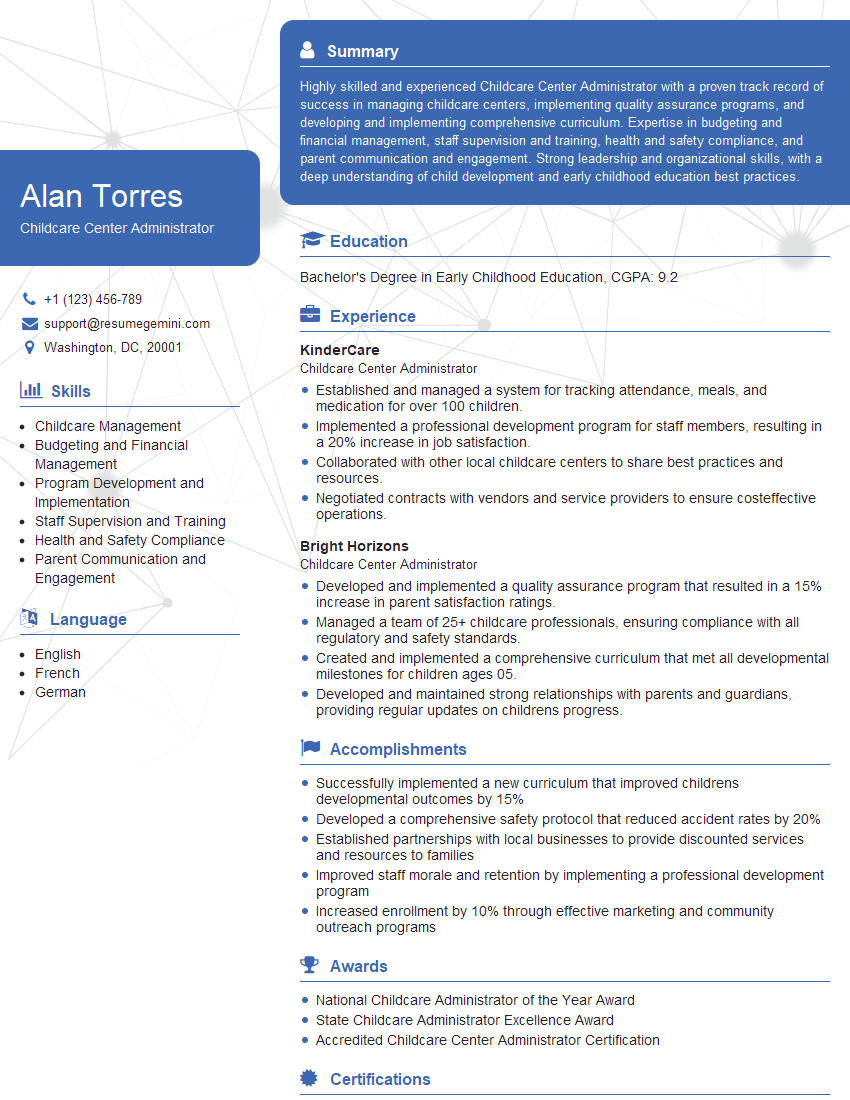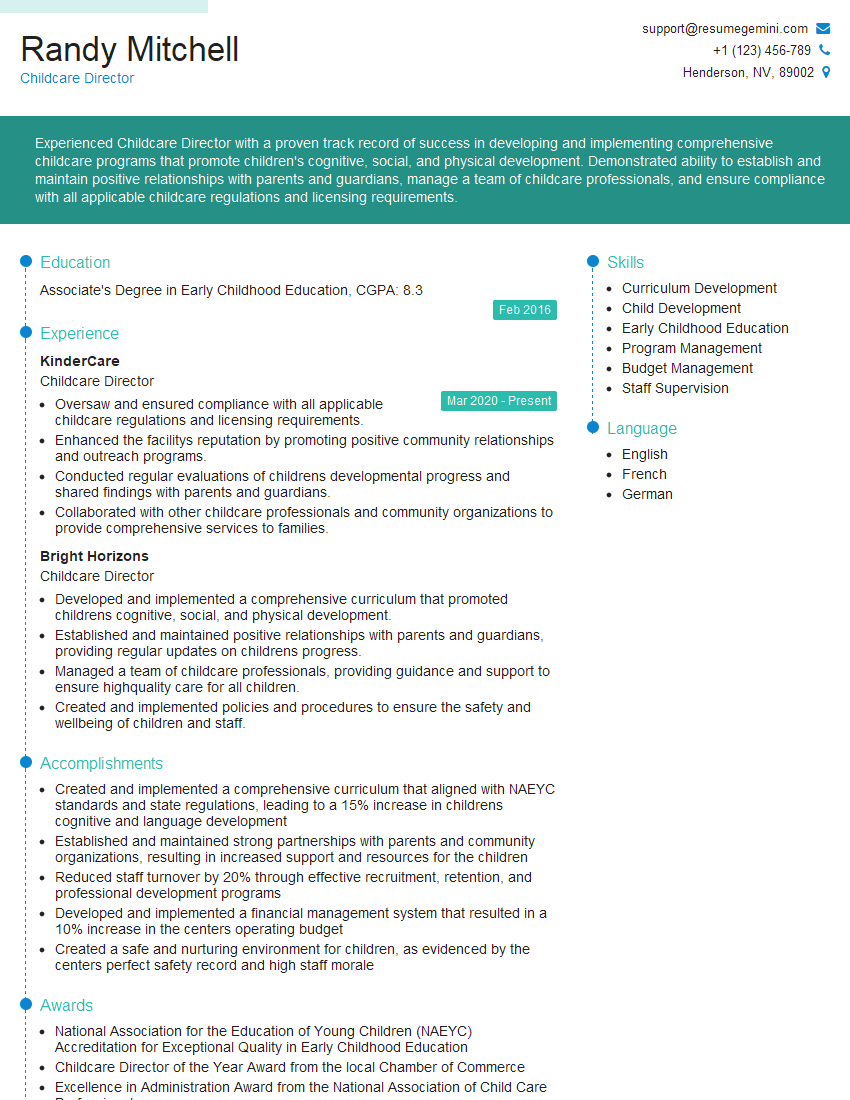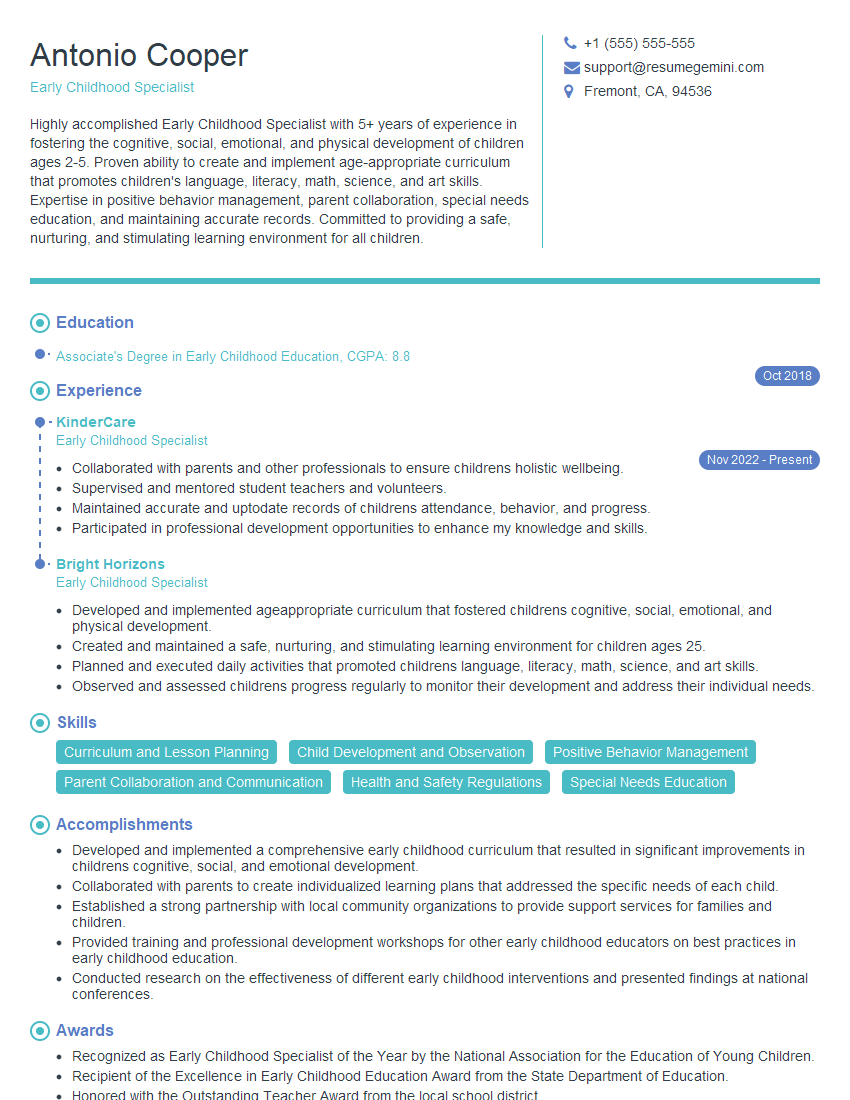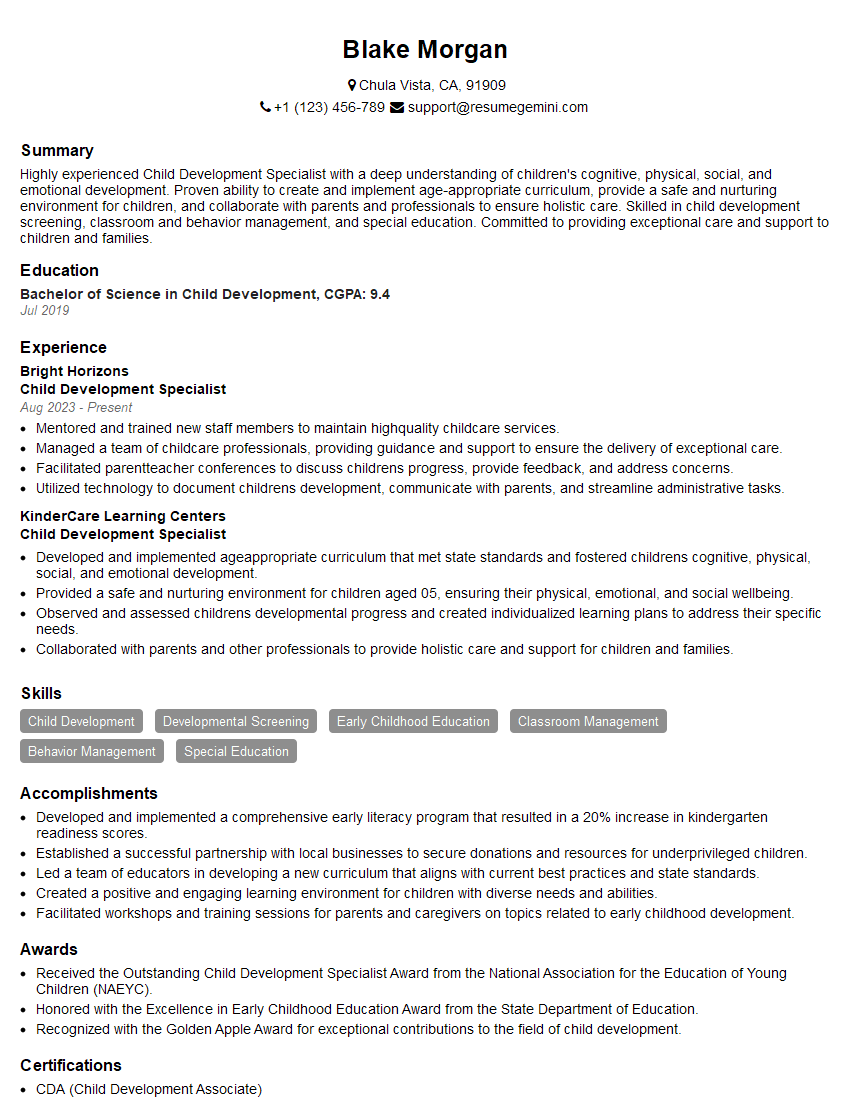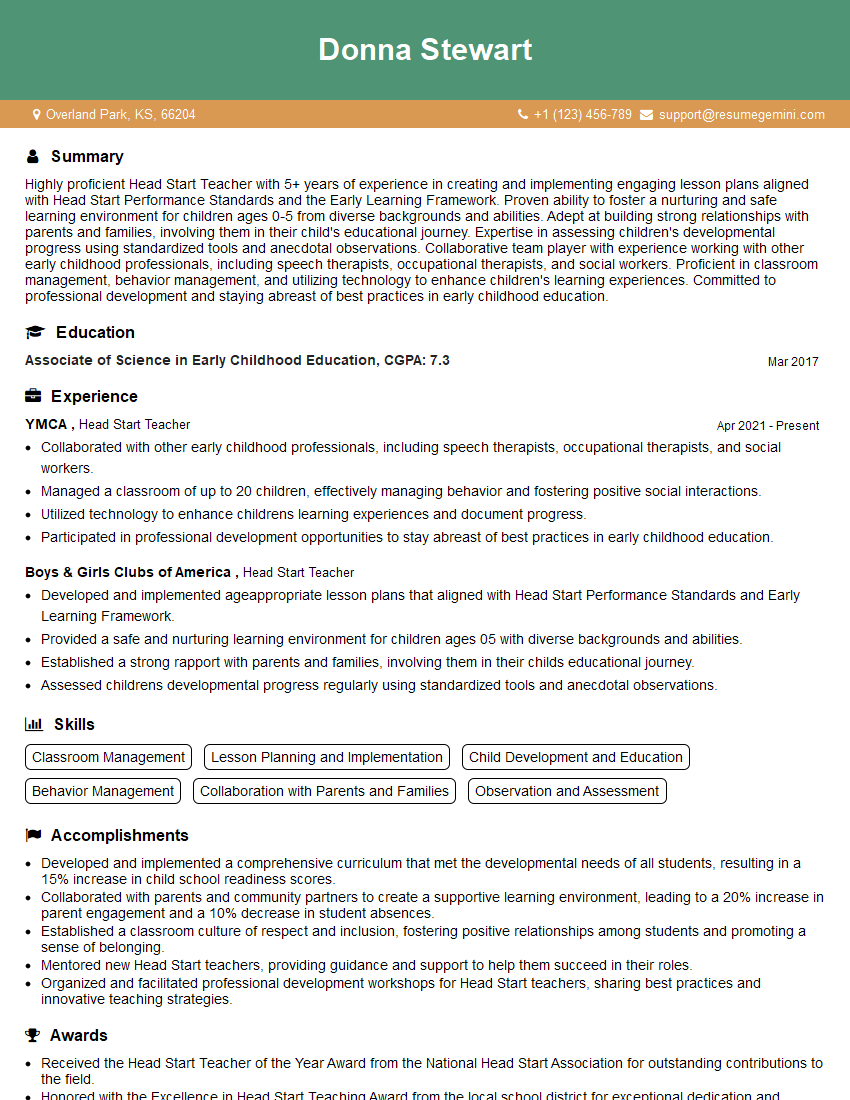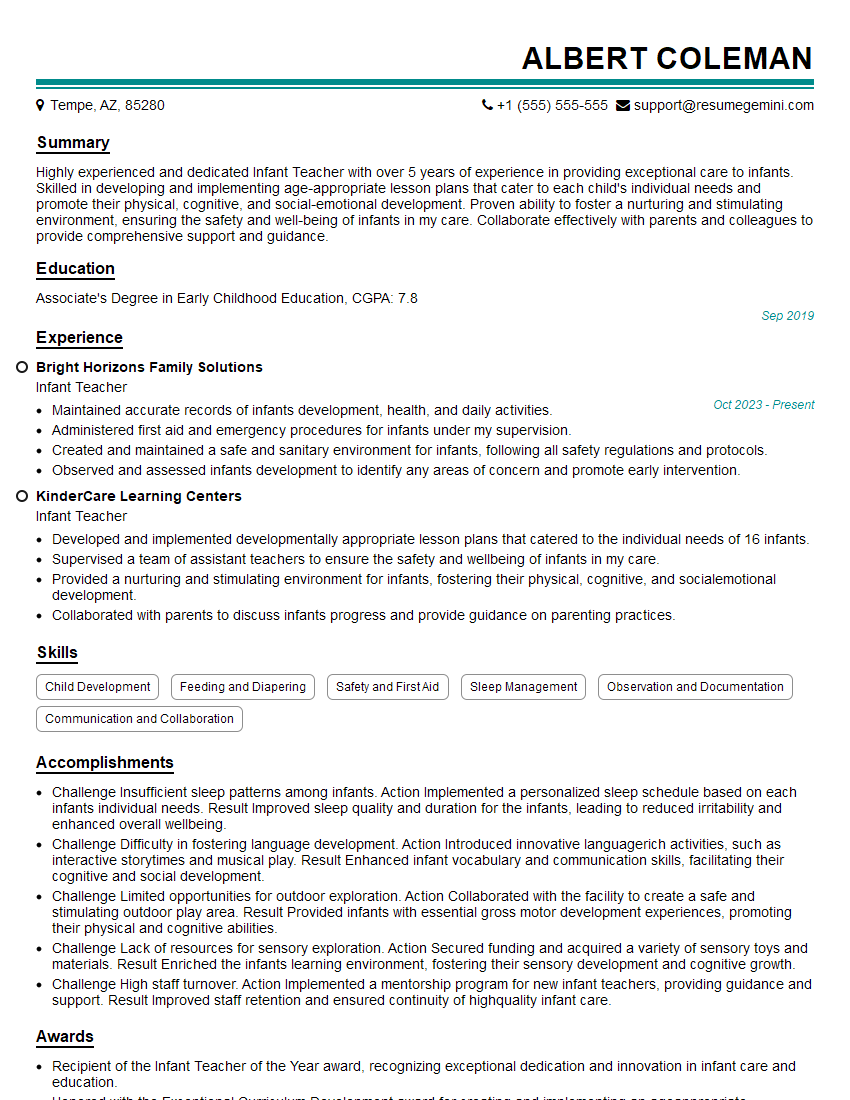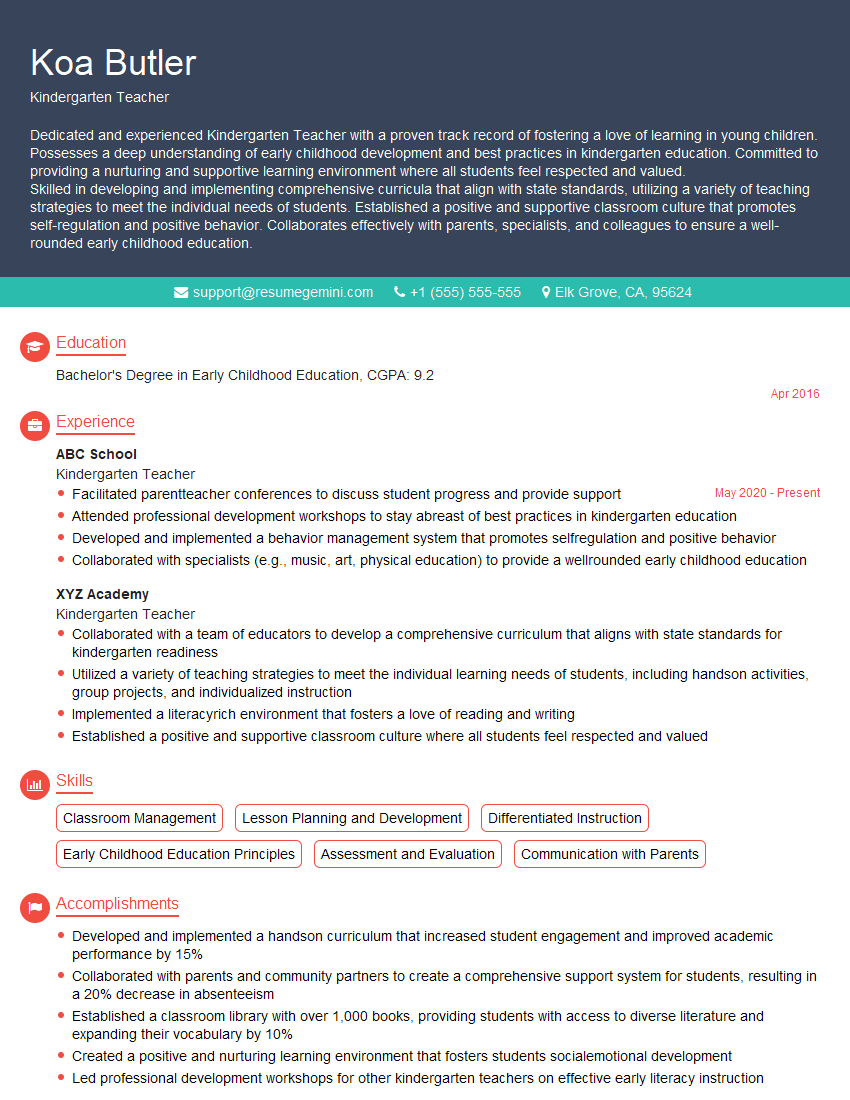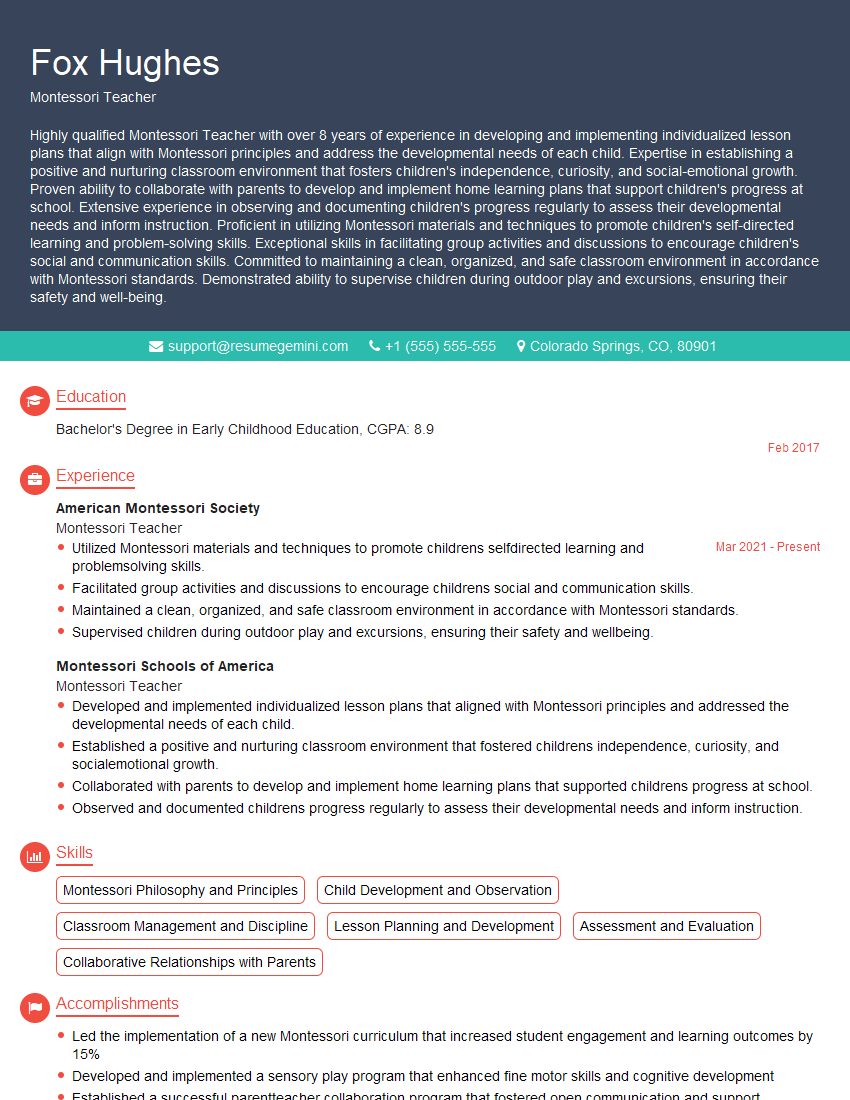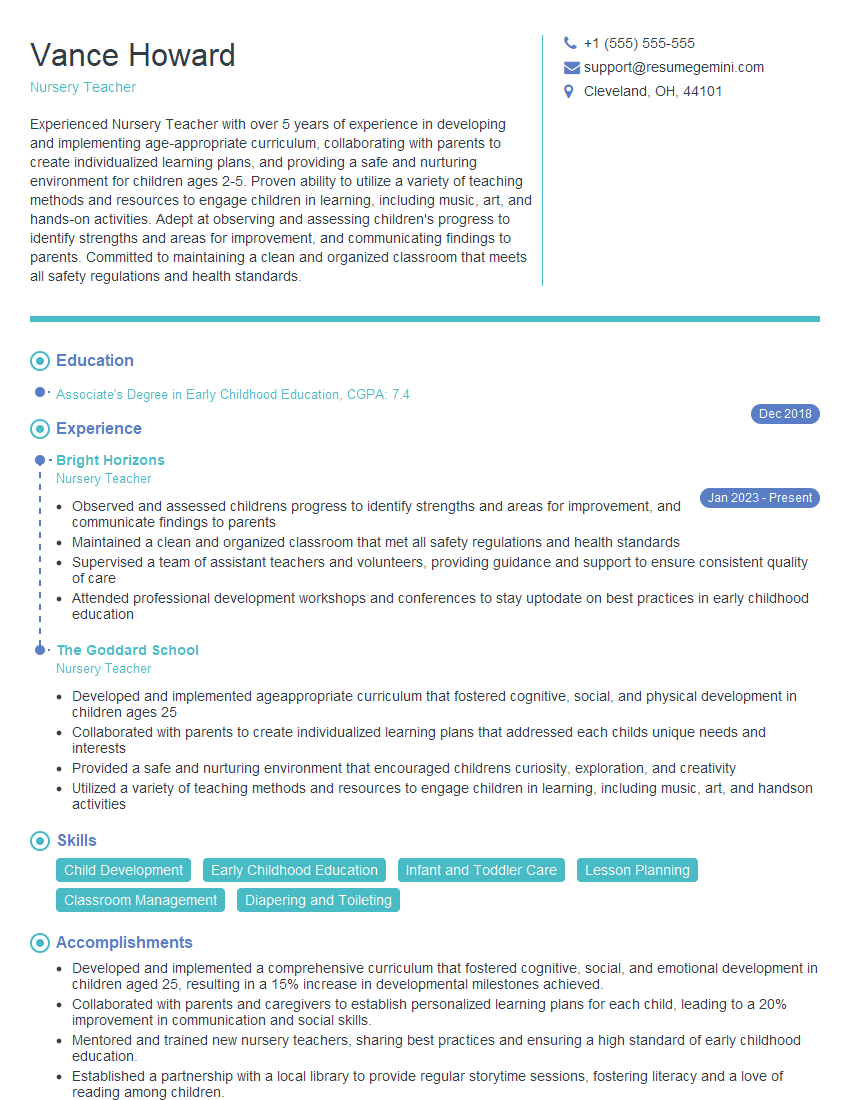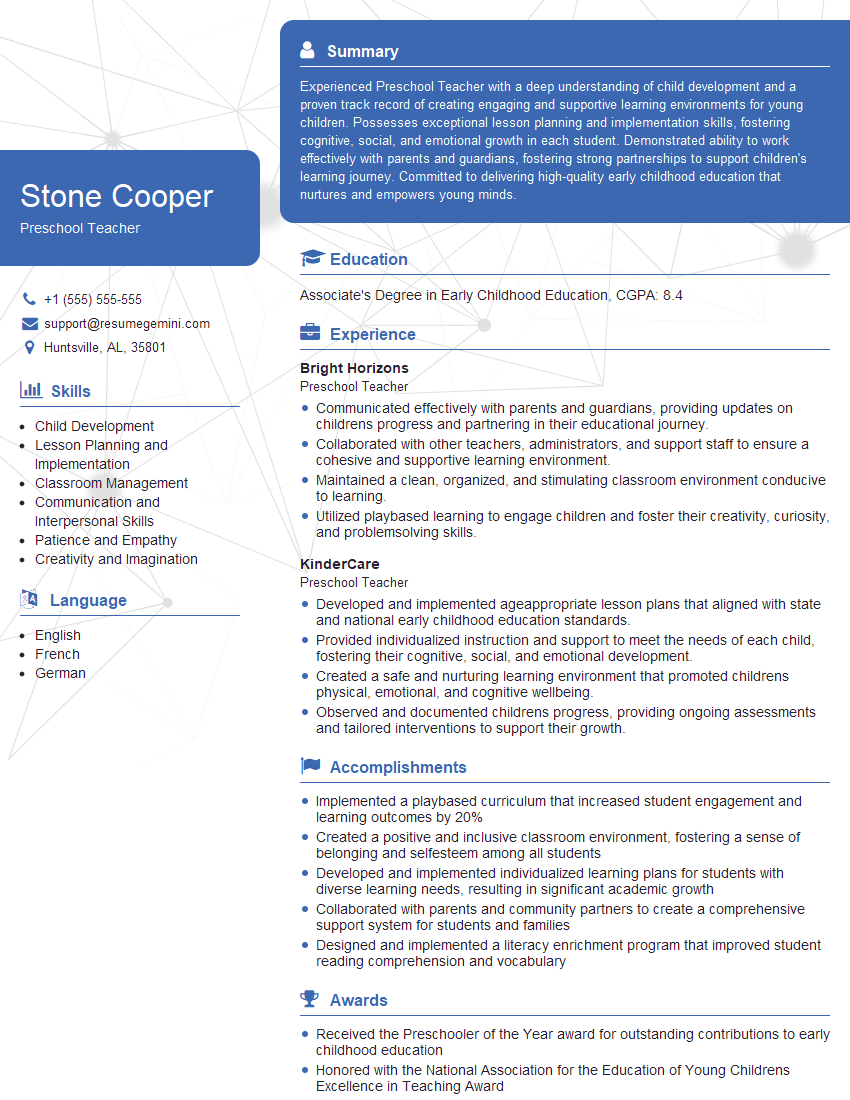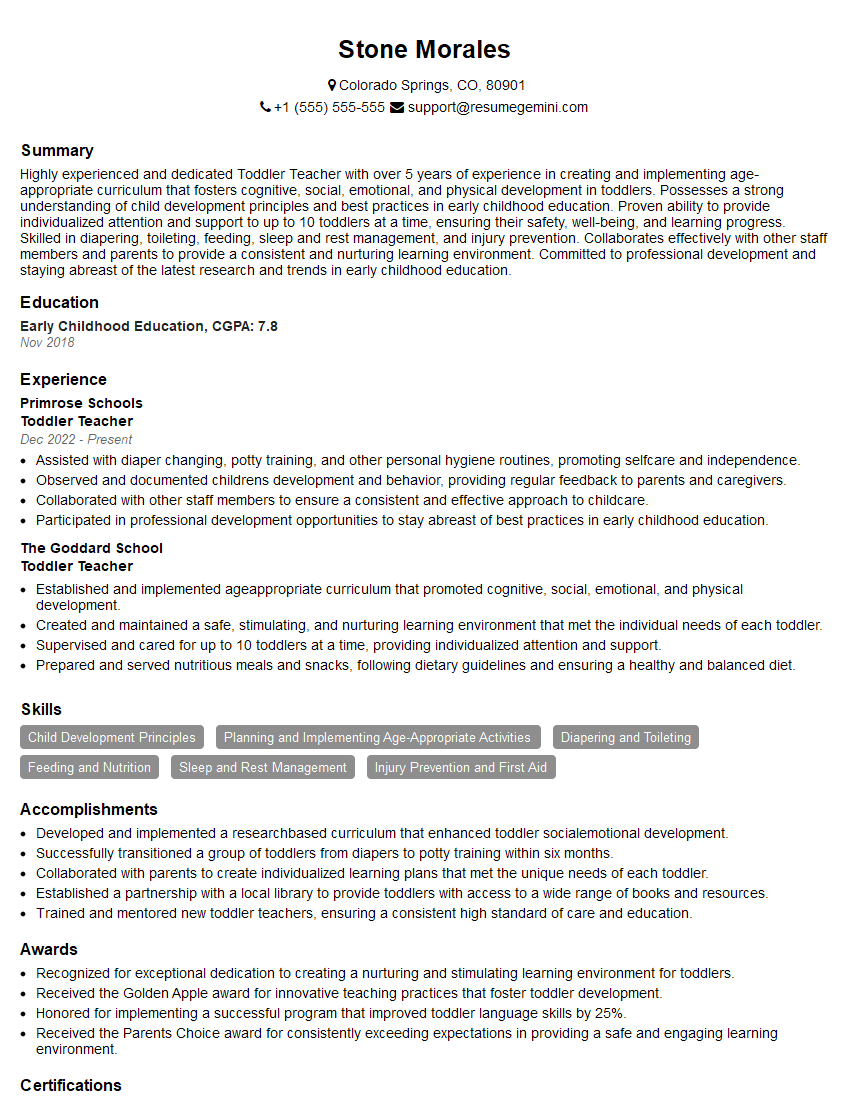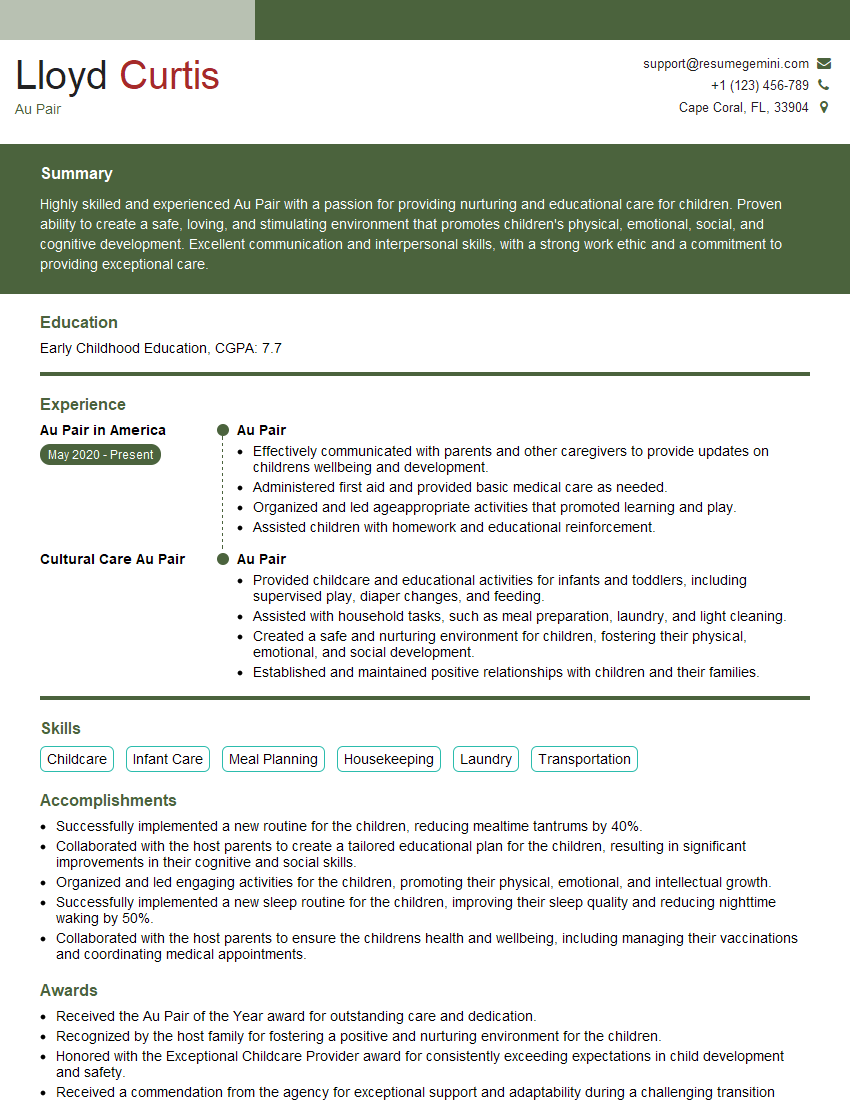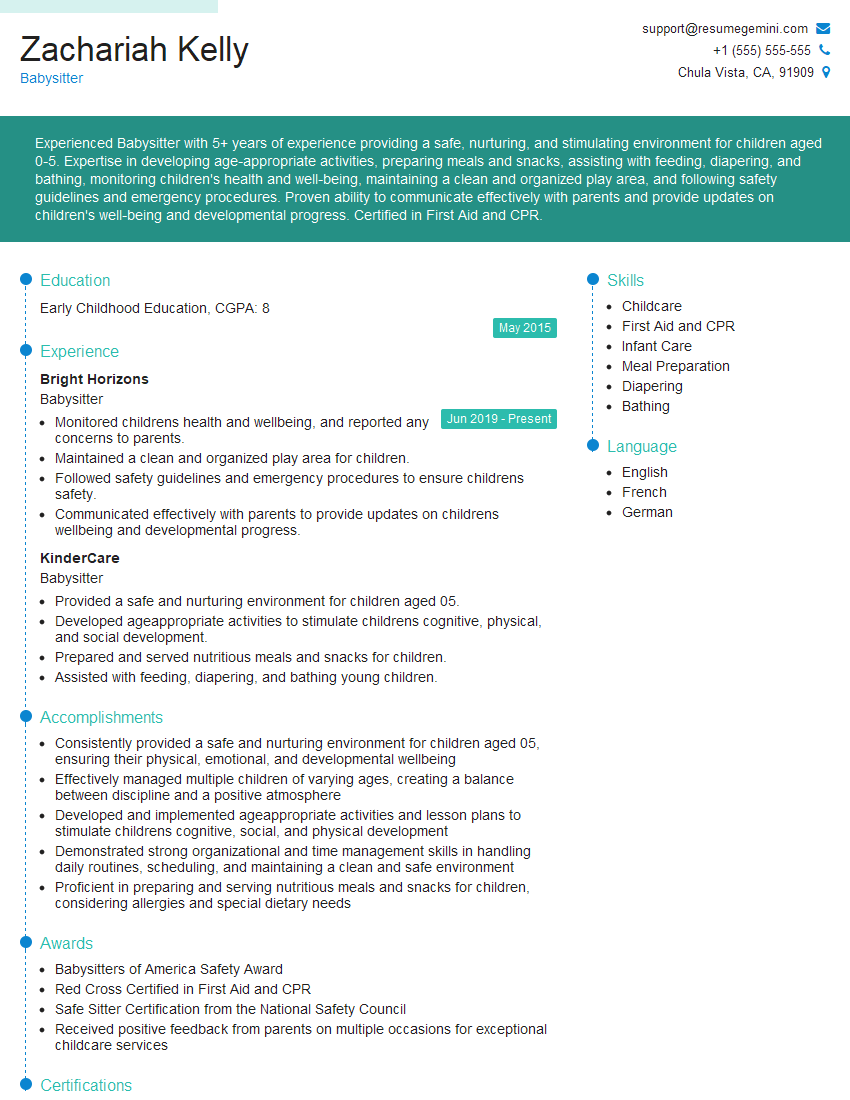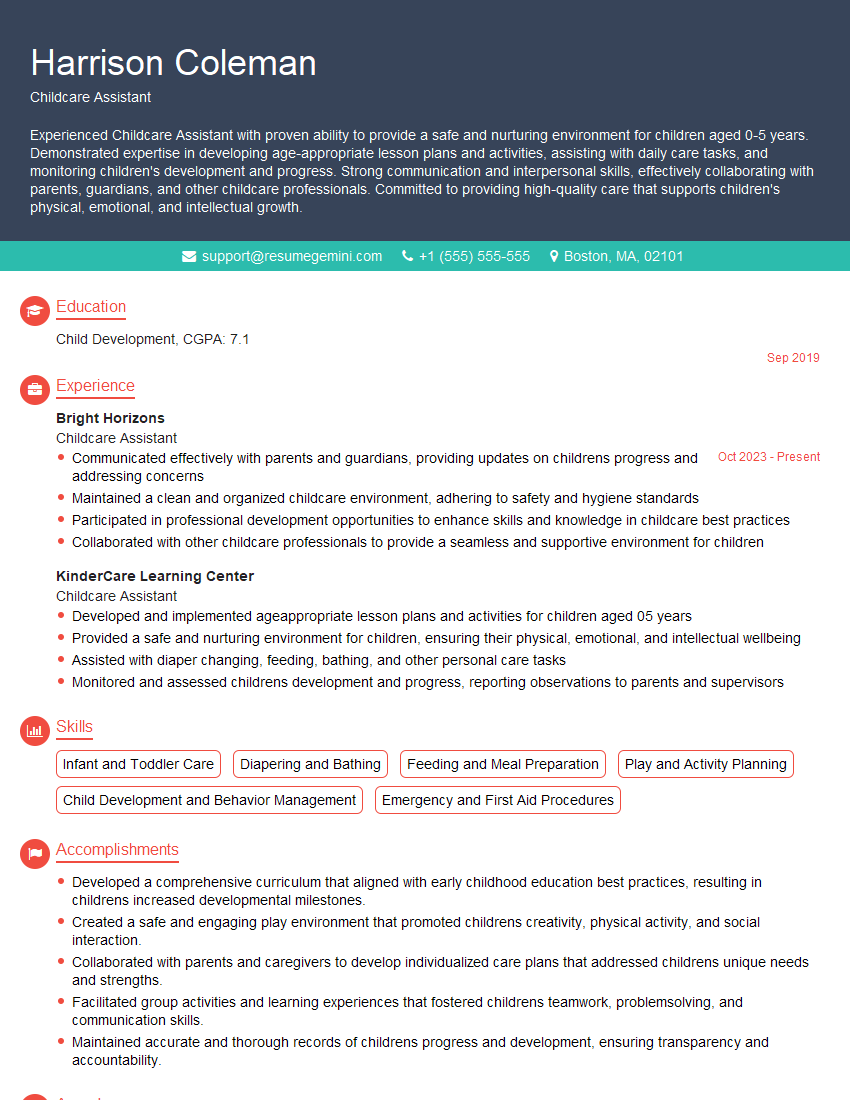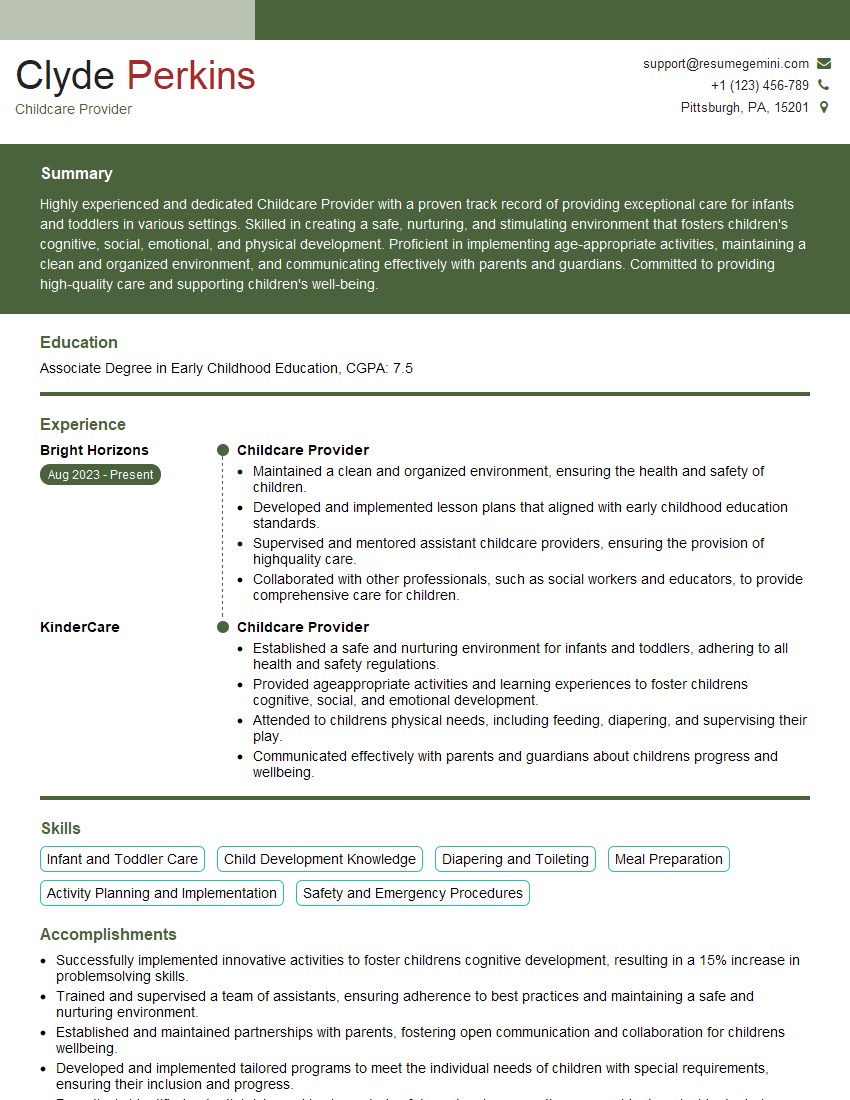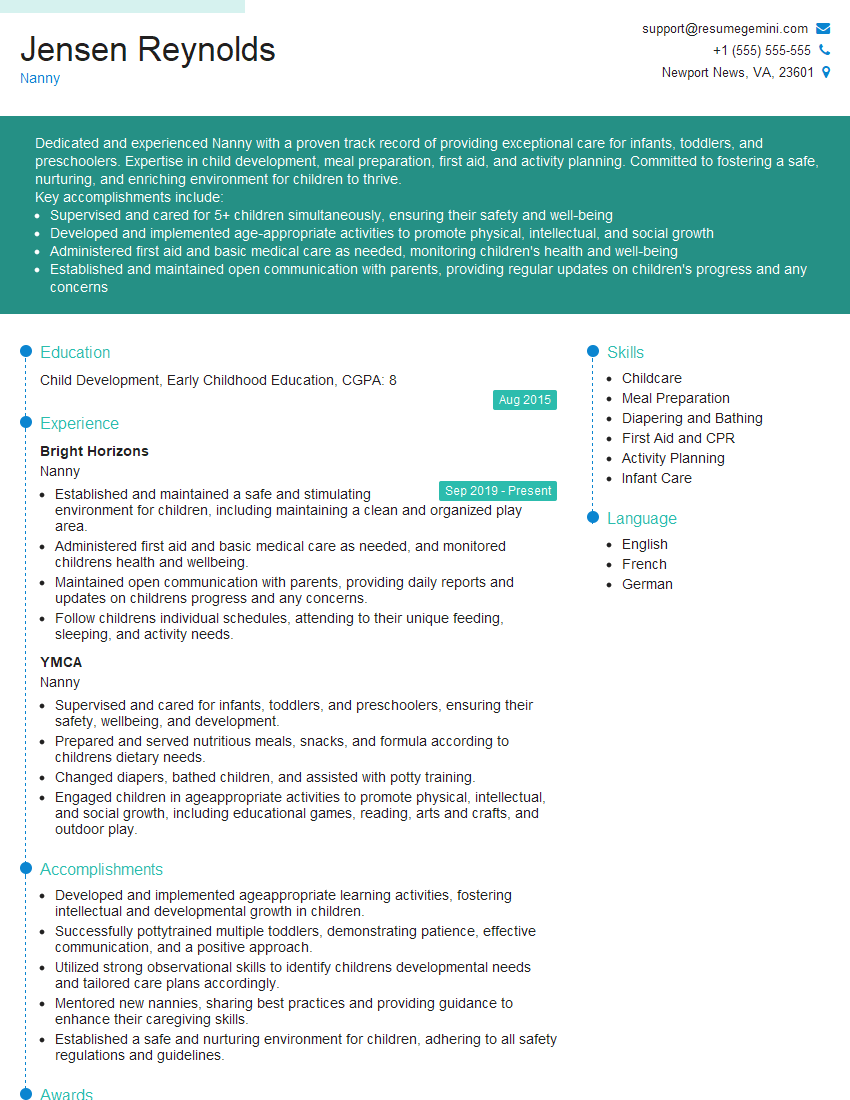Cracking a skill-specific interview, like one for Child Care, requires understanding the nuances of the role. In this blog, we present the questions you’re most likely to encounter, along with insights into how to answer them effectively. Let’s ensure you’re ready to make a strong impression.
Questions Asked in Child Care Interview
Q 1. Describe your experience managing classroom behavior in diverse age groups.
Managing classroom behavior across diverse age groups requires a multifaceted approach built on understanding developmental stages and individual needs. My strategy focuses on proactive measures like establishing clear expectations and routines from the start. For younger children (toddlers and preschoolers), this might involve visual schedules and consistent routines to provide predictability and security. With older children (pre-K and kindergarten), we incorporate age-appropriate discussions about classroom rules and expectations, reinforcing positive behaviors with praise and rewards.
Reactive strategies are also crucial. When misbehavior occurs, I address it calmly and consistently, focusing on understanding the underlying cause. For example, a tantrum might stem from hunger, tiredness, or frustration. Addressing the root cause is key; redirecting the child to a calming activity or providing a quiet space might be more effective than punishment. I also utilize positive reinforcement techniques, rewarding positive behavior with praise, stickers, or small privileges to encourage repetition.
In a mixed-age classroom, I adapt my strategies to suit the different developmental stages. Older children can sometimes act as positive role models for younger ones, and I leverage this dynamic to build a supportive classroom environment. For instance, I might pair an older child with a younger one during playtime, providing opportunities for mentorship and positive peer interaction. Differentiated instruction, where activities are tailored to individual skill levels, is crucial in managing behavior and keeping all children engaged and challenged. This ensures that children aren’t acting out due to boredom or frustration.
Q 2. Explain your approach to creating a developmentally appropriate curriculum.
Creating a developmentally appropriate curriculum is paramount to fostering holistic child development. My approach is centered around the principles of play-based learning, incorporating various learning domains like cognitive, social-emotional, physical, and creative development. I meticulously plan age-appropriate activities that cater to different learning styles and developmental needs. For example, a curriculum for toddlers might focus on sensory exploration and gross motor skills development through activities like finger painting and obstacle courses, while a curriculum for preschoolers might incorporate more structured activities focused on literacy, numeracy, and social skills development, such as story time, group projects and dramatic play.
I utilize various teaching methods such as project-based learning, where children collaboratively work on a project related to a specific theme, and inquiry-based learning, where children are encouraged to ask questions and explore answers through hands-on exploration. The curriculum incorporates regular assessments to gauge children’s progress and adjust the learning activities accordingly. I regularly consult resources like the National Association for the Education of Young Children (NAEYC) guidelines to ensure the curriculum aligns with best practices and relevant standards.
For example, if I notice that children are struggling with fine motor skills, I’ll adjust the curriculum to include more activities such as puzzles, threading beads, and using playdough to enhance these skills. Flexibility is key—I am always adapting the curriculum based on children’s interests and needs, observing and responding to their engagement levels and learning styles to achieve the best learning outcomes.
Q 3. How do you assess a child’s developmental progress?
Assessing a child’s developmental progress involves a holistic approach encompassing observation, documentation, and interaction. I utilize a variety of methods, including:
- Observation: I systematically observe children during various activities, noting their behavior, social interactions, and engagement levels. Anecdotal notes and checklists help record specific observations.
- Developmental Checklists and Screenings: These standardized tools provide a framework to assess children against age-appropriate milestones across different developmental domains, including cognitive, language, motor, social-emotional development. Examples include the Ages and Stages Questionnaires (ASQ).
- Work Samples and Portfolios: Children’s artwork, writing samples, and project work are collected and documented to show their progress over time.
- Parent-Teacher Conferences: These meetings provide valuable insights into the child’s development outside of the classroom setting. Combining classroom observations with parent input offers a comprehensive understanding of a child’s progress.
The data gathered from these methods is used to create a comprehensive picture of the child’s development. If a child shows significant delays or struggles, I consult with the parents and, if necessary, specialists like therapists or early intervention professionals to provide additional support. The aim is to identify any areas needing further attention and develop strategies to support the child’s growth.
Q 4. What strategies do you use to foster positive parent-teacher communication?
Fostering positive parent-teacher communication is crucial for a child’s success. My approach involves establishing open and consistent communication channels from the beginning. This starts with a welcoming and informative orientation for parents, outlining the program’s philosophy, curriculum, and expectations. Throughout the year, I use various methods to maintain open communication:
- Daily or Weekly Communication Logs/Apps: These are effective tools for sharing daily updates about the child’s activities, behavior, and learning achievements.
- Parent-Teacher Conferences: Formal conferences are scheduled regularly to discuss the child’s progress in detail and address any concerns. These are collaborative sessions where parents can share their observations and concerns and work with me to find solutions.
- Informal Communication: I actively engage in brief conversations with parents at drop-off and pick-up times, making myself available to answer any questions or concerns.
- Email and Phone Calls: These communication channels are used to address urgent matters or to facilitate communication between meetings.
- Newsletters and Email Updates: Periodic newsletters and email updates keep parents informed about classroom events and upcoming activities.
Active listening, empathy, and respect are central to my communication style. I ensure that parents feel valued partners in their child’s education and are comfortable sharing information and concerns without hesitation. The goal is to create a collaborative relationship built on mutual trust and respect.
Q 5. How do you handle challenging behaviors in young children?
Handling challenging behaviors in young children requires a calm, consistent, and developmentally appropriate approach. I follow a structured approach that prioritizes understanding the underlying causes of the behavior before implementing interventions.
1. Understanding the Behavior: I start by observing the child to identify patterns and triggers. Is the behavior linked to specific times of day, activities, or social interactions? A child’s frustration, tiredness, or hunger can often manifest as challenging behavior.
2. Positive Guidance Techniques: I focus on redirecting the child’s attention to more appropriate activities, providing choices, and offering positive reinforcement for good behavior. For example, if a child is hitting, I might redirect them to a quiet corner with a calming activity, or I might offer a different way to express their anger.
3. Consistent Discipline: Consistent discipline is vital. This involves using clear and consistent rules and consequences. The consequence should be age-appropriate and related to the misbehavior. A time-out, for example, allows a child to calm down before re-joining the group.
4. Collaborating with Parents: Working closely with parents is crucial for consistency. I communicate with parents about the strategies I’m using and encourage them to implement similar strategies at home. Consistency in approach between home and school greatly increases the effectiveness of behavior management techniques.
5. Seeking Professional Support: If the challenging behavior persists or is severe, I will consult with specialists, such as child psychologists or therapists, to get additional support and guidance. This might involve creating a behavior plan with specific strategies tailored to the child’s needs.
Q 6. Describe your experience with different learning styles and developmental needs.
My experience working with children with diverse learning styles and developmental needs highlights the importance of individualized instruction. I understand that children learn in different ways and at different paces. Some children are visual learners, others auditory, and still others kinesthetic. Some children may have learning disabilities or other developmental needs that require specialized support.
To cater to diverse learning styles, I use various teaching methods, including visual aids, hands-on activities, storytelling, songs, and games. I differentiate instruction by modifying tasks and materials to meet each child’s individual needs. For example, I might provide a child struggling with writing a larger pencil grip or allow them to dictate their answers to an adult. For children with auditory processing difficulties, I might supplement auditory instructions with visual cues and provide additional time for processing information.
I have experience working with children with diagnosed conditions like ADHD, autism spectrum disorder, and speech delays. I am familiar with strategies for supporting these children and adapt my teaching approaches to meet their specific needs. This might involve creating a quiet space for sensory regulation, using visual supports to improve communication, or working with specialized therapists to design individual education plans. Collaboration with parents, therapists, and other specialists is essential in providing the best possible support for these children.
My approach is centered around creating a supportive and inclusive environment where each child feels valued and respected. I celebrate the unique talents and strengths of every child and strive to help them reach their full potential.
Q 7. Explain your knowledge of child safety regulations and procedures.
Child safety is my utmost priority. My understanding of child safety regulations and procedures encompasses several key areas:
- Emergency Procedures: I am thoroughly trained in emergency response protocols, including fire drills, lockdown procedures, and evacuation plans. I ensure that all staff members are also well-versed in these procedures and that the children are regularly practiced in drills to build familiarity and confidence.
- Health and Safety Regulations: I am familiar with state and local regulations related to child care, including licensing requirements, health and hygiene practices, and food safety guidelines. This includes adhering to strict handwashing protocols, maintaining clean and safe environments, and implementing age-appropriate safety measures.
- Supervision and Safety Ratios: I always adhere to the appropriate staff-to-child ratios for the age group of children I am supervising. Maintaining close supervision is crucial to prevent accidents and ensure children’s safety.
- Injury Prevention: I implement proactive measures to prevent injuries such as securing hazardous materials, inspecting play areas for hazards, and providing age-appropriate equipment.
- Transportation Safety: When transporting children, I follow all relevant traffic laws and safety regulations. This includes using appropriately sized car seats and booster seats and following secure transportation procedures.
- Reporting and Documentation: I follow strict procedures for reporting any incidents, injuries, or suspected abuse to the appropriate authorities in accordance with the mandates laid out by the governing bodies.
Continuous training and staying updated on best practices in child safety are crucial aspects of my role. My commitment to safety extends to creating a culture of safety awareness within the classroom, teaching children about safety rules, and promoting safe behaviors.
Q 8. How do you maintain a clean and safe environment for children?
Maintaining a clean and safe environment is paramount in childcare. It’s not just about tidiness; it’s about preventing accidents and fostering a healthy learning space. My approach is multi-faceted and proactive.
- Regular Cleaning and Sanitizing: We follow a strict cleaning schedule, sanitizing high-touch surfaces like tables, doorknobs, and toys multiple times a day. This includes regular deep cleaning of the entire facility.
- Hazard Prevention: We conduct regular safety checks, identifying and removing potential hazards like loose wires, sharp objects, or tripping hazards. Age-appropriate areas are carefully designed to minimize risks.
- Safe Storage of Materials: Cleaning supplies, medications, and potentially hazardous materials are stored securely and out of children’s reach, with appropriate labeling and safety protocols followed.
- Proper Waste Disposal: We maintain a system for proper disposal of waste, including diapers, food scraps, and other materials, adhering to all relevant health and safety regulations.
- Emergency Preparedness: We have well-defined emergency procedures, including fire drills, and emergency contact lists for each child. First aid kits are readily available and staff are trained in basic first aid and CPR.
For example, after snack time, we immediately wipe down tables and clear away crumbs. Before nap time, we ensure all toys are properly stored and the sleeping area is well-ventilated and clean.
Q 9. How do you incorporate play-based learning into your teaching methods?
Play-based learning is the cornerstone of my teaching methodology. I believe that children learn best through active engagement and exploration. It’s not just about fun; it’s about fostering cognitive, social-emotional, and physical development.
- Themed Activities: We use thematic units to build upon children’s interests, like a unit on farm animals incorporating pretend play, crafts, and songs.
- Open-Ended Play: Providing children with open-ended materials like blocks, art supplies, and dress-up clothes allows them to create and explore their imagination.
- Dramatic Play: We incorporate dramatic play scenarios to encourage role-playing, social interaction, and creative expression – like setting up a pretend doctor’s office or a grocery store.
- Sensory Play: Activities involving different textures, smells, and sounds, like playing with sand, water, or playdough stimulate senses and enhance learning.
- Outdoor Play: Outdoor time is crucial for physical activity and exploring nature. We go on nature walks, play games, and use outdoor learning resources.
For instance, during a unit on transportation, children might build vehicles from blocks, draw pictures of different modes of transport, and even create a pretend airport scene with costumes and props.
Q 10. Describe your experience with various child care philosophies (e.g., Montessori, Reggio Emilia).
I’ve had the opportunity to work within settings influenced by various child care philosophies, enriching my understanding of child development.
- Montessori: I’ve observed Montessori classrooms emphasizing self-directed activity, hands-on learning, and collaborative play. The structured environment with age-appropriate materials facilitates independent exploration and skill development. I’ve adapted some Montessori principles into my own practice, such as providing children with choices and allowing them to work at their own pace.
- Reggio Emilia: This approach prioritizes the child’s natural curiosity and encourages creative expression through art, music, and dramatic play. The teacher acts as a facilitator, guiding exploration and documentation of the learning process. I appreciate the Reggio Emilia emphasis on documentation, using photos and observations to track a child’s learning journey.
Understanding these different philosophies helps me create a flexible and inclusive learning environment tailored to individual needs and learning styles.
Q 11. How do you manage multiple children simultaneously while maintaining individual attention?
Managing multiple children while maintaining individual attention requires skillful organization and a proactive approach. It’s a balancing act.
- Organized Classroom Structure: A well-structured classroom with designated areas for different activities minimizes chaos and facilitates supervision.
- Individualized Attention: I use techniques like ‘circling’ – briefly interacting with each child during free play – to ensure everyone feels seen and heard. I also plan one-on-one interactions throughout the day.
- Classroom Routines: Established routines create predictability, reducing anxiety and allowing for focused interactions. Transitions between activities are well-planned and clearly communicated.
- Small Group Activities: I often use small group activities to provide more focused attention and facilitate peer interaction. This allows me to work closely with a smaller number of children, addressing specific needs while keeping others engaged.
- Positive Reinforcement: I actively praise positive behaviors and offer encouragement to build confidence and self-esteem in each child.
For instance, during free play, I might chat with one child building a tower, help another with a puzzle, and encourage a third to join a collaborative game, all while keeping a watchful eye on the whole group.
Q 12. What is your experience with children with special needs?
I have experience working with children with diverse needs, including those with learning disabilities, developmental delays, and emotional challenges. My approach is always inclusive and individualized.
- Individualized Education Plans (IEPs): I work closely with parents and specialists to implement IEPs, tailoring activities and support to meet the specific needs of each child.
- Collaboration with Specialists: I regularly communicate with therapists, special education teachers, and other professionals to ensure a coordinated and comprehensive approach.
- Adaptive Strategies: I adapt teaching methods and materials to meet the unique learning styles and challenges of children with special needs, modifying tasks, using assistive technologies, or providing additional support.
- Creating an Inclusive Environment: I foster an inclusive classroom where all children feel valued, respected, and supported, regardless of their abilities or challenges.
- Patience and Understanding: Working with children with special needs requires patience, understanding, and a commitment to creating a safe and nurturing environment.
For example, I might modify a craft activity for a child with fine motor skill challenges by using larger materials or providing adaptive tools.
Q 13. How do you plan and implement daily activities for children?
Daily planning is essential for a successful childcare program. My planning process is flexible but structured, incorporating both child-led and teacher-led activities.
- Weekly Themes: I plan weekly themes that integrate different learning areas and align with children’s interests. This provides a cohesive learning experience.
- Daily Schedule: A consistent daily schedule provides structure and predictability, reducing anxiety and allowing for smooth transitions between activities.
- Variety of Activities: The daily schedule includes a balance of active and quiet activities, both teacher-led and child-initiated, catering to different learning styles and energy levels.
- Flexibility and Adaptability: While I have a planned schedule, I am flexible and adaptable to children’s interests and needs. Sometimes, a child’s spontaneous question can spark a fascinating learning opportunity.
- Documentation and Assessment: I document daily activities and observe children’s progress, using this information to inform future planning and adjust activities based on their learning needs.
A typical day might include circle time, free play, art, snack, outdoor time, and story time. But the specific activities within each segment will vary depending on the weekly theme and children’s interests.
Q 14. Describe your experience with emergency procedures (e.g., fire drills, medical emergencies).
Emergency procedures are an integral part of childcare safety. I’m trained and experienced in handling various emergency situations.
- Fire Drills: We conduct regular fire drills to ensure children and staff know and understand evacuation procedures. We practice calmly and efficiently.
- Medical Emergencies: I’m trained in first aid and CPR. Our facility has well-stocked first aid kits and clear protocols for dealing with minor injuries and illnesses, as well as procedures for contacting emergency services.
- Severe Weather Procedures: We have plans in place for severe weather events, including lockdowns and evacuations, keeping the safety of the children as the top priority.
- Emergency Contact Information: We maintain up-to-date emergency contact information for each child, including parents, guardians, and alternative contacts.
- Security Measures: We have security measures in place to control access to the facility, monitor children, and ensure safety and security.
During a fire drill, for instance, I make sure to remain calm and reassuring, guiding the children calmly and efficiently to the designated assembly point, ensuring each child is accounted for.
Q 15. How do you promote children’s social-emotional development?
Promoting children’s social-emotional development is crucial for their overall well-being and future success. It involves nurturing their ability to understand and manage their emotions, build healthy relationships, and navigate social situations effectively. This is achieved through a multifaceted approach.
Creating a Safe and Supportive Environment: A classroom where children feel safe, respected, and valued is fundamental. This includes establishing clear rules and expectations, consistently enforcing them with kindness and firmness, and offering plenty of opportunities for positive interaction.
Modeling Positive Behaviors: Children learn by observing adults. By demonstrating empathy, emotional regulation, and respectful communication, we teach them valuable social-emotional skills. For instance, if a child gets frustrated, I might model taking deep breaths and calmly explaining the situation.
Teaching Emotional Literacy: Helping children identify and name their emotions is key. We use picture cards, storybooks, and role-playing to teach them about different feelings. For example, we might discuss what ‘sad,’ ‘angry,’ and ‘happy’ feel like and how to express these feelings appropriately.
Encouraging Social Interaction: Structured activities like group projects, collaborative games, and dramatic play promote teamwork, cooperation, and conflict resolution. I actively facilitate these interactions, guiding children towards positive communication and conflict resolution strategies.
Providing Individualized Support: Each child develops at their own pace. I observe children closely to identify individual needs and provide tailored support. For example, a shy child might benefit from one-on-one activities, while a more assertive child might need guidance in sharing and taking turns.
Career Expert Tips:
- Ace those interviews! Prepare effectively by reviewing the Top 50 Most Common Interview Questions on ResumeGemini.
- Navigate your job search with confidence! Explore a wide range of Career Tips on ResumeGemini. Learn about common challenges and recommendations to overcome them.
- Craft the perfect resume! Master the Art of Resume Writing with ResumeGemini’s guide. Showcase your unique qualifications and achievements effectively.
- Don’t miss out on holiday savings! Build your dream resume with ResumeGemini’s ATS optimized templates.
Q 16. Explain your understanding of child development stages and milestones.
Understanding child development stages and milestones is essential for creating appropriate and effective learning experiences. I am familiar with various developmental theories, including Piaget’s stages of cognitive development, Erikson’s stages of psychosocial development, and Vygotsky’s sociocultural theory. These frameworks help me understand the typical progression of physical, cognitive, social, and emotional development in children.
For example, in the preschool years (ages 3-5), children are typically developing language skills rapidly, engaging in imaginative play, and showing increasing independence. Knowing this, I plan activities that encourage language development through storytelling and singing, provide opportunities for imaginative play through dramatic play centers, and support their growing independence through self-help skills like dressing and toileting. I also recognize that developmental milestones are not rigid; there is a range of what is considered typical. I always document individual progress and adapt my teaching to meet the specific needs of each child.
Q 17. How do you adapt your teaching strategies to meet individual children’s needs?
Adapting teaching strategies to meet individual children’s needs is a cornerstone of effective childcare. This requires careful observation, assessment, and flexible planning. I use a variety of techniques to personalize the learning experience:
Differentiated Instruction: I tailor activities to different learning styles and abilities. For example, a child who struggles with fine motor skills might participate in a large-motor activity, while a child who excels in math can work on more challenging problems.
Individualized Learning Plans (ILPs): For children with identified developmental delays or special needs, I collaborate with parents and specialists to create ILPs that outline specific goals and strategies. These plans guide my instruction and help me track the child’s progress.
Universal Design for Learning (UDL): I apply UDL principles to create learning environments that are accessible to all children, regardless of their learning styles or abilities. This includes providing multiple means of representation, action, and engagement.
Regular Assessment and Monitoring: I regularly observe children’s progress and adjust my teaching as needed. This might involve changing an activity, providing additional support, or offering more challenging tasks.
For instance, if I notice a child struggling to understand a concept during a group lesson, I might provide one-on-one support, use different teaching materials, or break down the task into smaller, more manageable steps.
Q 18. What is your experience with lesson planning and curriculum development?
Lesson planning and curriculum development are integral parts of my role. I believe in a play-based, emergent curriculum that integrates children’s interests and developmental needs. My planning process typically involves:
Identifying Learning Goals: I begin by identifying the learning goals for a specific period, aligning them with relevant developmental milestones and standards.
Choosing Relevant Themes and Activities: I select themes and activities that are engaging and relevant to children’s interests, considering their developmental stage and learning styles. I incorporate a balance of teacher-directed and child-initiated activities.
Gathering Resources: I gather appropriate materials, books, and other resources needed to support the planned activities. This includes ensuring access to manipulatives and diverse learning materials.
Assessing and Evaluating: I regularly assess children’s learning and adjust my plans based on their progress. I utilize observation checklists, anecdotal records, and informal assessments.
For example, a theme on ‘animals’ might include activities such as reading animal books, constructing animal habitats, and engaging in dramatic play where children role-play different animal characters. The curriculum is flexible and adapts to the children’s discoveries and questions during the learning process.
Q 19. Describe your experience with documentation and record keeping in a childcare setting.
Documentation and record-keeping are crucial for monitoring children’s progress, communicating with parents, and ensuring compliance with regulations. I maintain comprehensive records using a combination of methods:
Daily Logs: I maintain daily records of each child’s attendance, activities participated in, and significant events.
Anecdotal Records: I write short, descriptive accounts of children’s behavior, interactions, and learning experiences. These observations provide insights into children’s strengths and areas for development.
Portfolio Assessment: I collect children’s artwork, writing samples, and other work to showcase their progress and growth over time. This allows parents and educators to see individual child development.
Digital Documentation: I use technology to create digital portfolios and store records securely. This also aids in sharing with parents and other professionals.
All records are kept confidential and comply with relevant privacy regulations. I ensure parents have access to their child’s records and actively involve them in the documentation process.
Q 20. How do you build rapport with children and their families?
Building rapport with children and their families is essential for creating a trusting and supportive learning environment. I achieve this through:
Positive Communication: I communicate regularly with parents through newsletters, daily reports, and parent-teacher conferences. I use clear, concise language and actively listen to their concerns and feedback.
Building Relationships with Children: I get down to their level, listen attentively to their stories, and show genuine interest in their lives and activities. I use positive reinforcement and celebrate their achievements. For example, taking a child’s suggestions for a game or offering a warm hug goes a long way in building a trusting relationship.
Showing Empathy and Respect: I show empathy and understanding for both children and parents, respecting their individual needs and preferences. I create a welcoming and inclusive atmosphere where everyone feels valued.
Open-Door Policy: I encourage parents to contact me with any questions or concerns. I make myself available for informal chats and meetings. A consistent approach builds trust over time.
For instance, by remembering a child’s favorite story or asking about their family pet, I show genuine interest and create a connection. With families, I proactively communicate changes to the program or upcoming events to ensure everyone is in the loop and aware of what’s happening.
Q 21. Describe your experience with working collaboratively with other childcare professionals.
Collaboration is crucial in a childcare setting. I have extensive experience working effectively with other childcare professionals, including teachers, administrators, specialists, and support staff. My collaborative approach includes:
Regular Team Meetings: I participate actively in team meetings, sharing observations, insights, and ideas. These meetings ensure consistency and collaboration in our approaches.
Co-planning and Co-teaching: I collaborate with colleagues on lesson planning and co-teach activities to provide rich and diverse learning experiences.
Sharing Best Practices: I share best practices and resources with my colleagues to enhance our overall effectiveness. This creates a synergistic environment.
Open Communication: I maintain open and respectful communication with colleagues, sharing observations and concerns promptly and professionally. Addressing challenges constructively ensures team success.
Seeking Support and Mentorship: I actively seek support and mentorship from experienced colleagues, learning from their expertise and sharing my own insights to grow professionally.
For example, when working with a special education teacher, I would co-create lesson plans that cater to the specific needs of a child while still allowing that child to participate in the general classroom activities. This collaborative approach ensures every child is fully supported and included.
Q 22. How do you ensure inclusivity and diversity in your classroom?
Creating an inclusive and diverse classroom is paramount. It’s about ensuring every child feels valued, respected, and has equal opportunities to learn and grow, regardless of their background, abilities, or differences. I achieve this through several key strategies.
Curriculum Representation: I intentionally incorporate diverse characters, stories, and perspectives into our learning activities. This includes books, toys, and classroom decorations that reflect a variety of cultures, ethnicities, and abilities. For example, we might read stories about children from different countries or explore different cultural celebrations.
Culturally Responsive Teaching: I adapt my teaching methods to meet the diverse learning styles and needs of each child. This involves understanding their cultural backgrounds and incorporating their prior knowledge into lessons. For example, if a child is familiar with a particular art form from their culture, I’ll integrate that into our art projects.
Inclusive Language: I use inclusive language that avoids stereotypes and promotes respect for all individuals. I actively model this behavior and encourage children to do the same.
Collaboration with Families: I regularly communicate with parents to learn about their child’s home culture and any specific needs or preferences. This helps me to create a supportive and welcoming environment for every child.
Accessibility: I ensure the classroom is physically accessible to children with disabilities and provide appropriate accommodations as needed. This might involve adapting activities or using assistive technology.
Q 23. How do you handle parent concerns and complaints?
Addressing parent concerns and complaints is a crucial part of building strong parent-teacher relationships. My approach focuses on open communication, active listening, and finding collaborative solutions.
Active Listening: I always start by actively listening to the parent’s concerns without interruption, ensuring I fully understand their perspective. I use phrases like, “I understand your concern about…” or “Tell me more about…” to show empathy and encourage them to share their thoughts.
Collaborative Problem-Solving: Once I understand their concern, I work collaboratively with the parent to identify the root cause and develop a solution. This might involve modifying a classroom routine, adjusting a child’s learning plan, or offering additional support. For example, if a parent is concerned about their child’s behavior, we might work together to develop a behavior management plan.
Documentation and Follow-Up: I document all concerns and actions taken, ensuring a clear record of our interactions. I also follow up with the parent to monitor the effectiveness of the solution and make any necessary adjustments.
Professionalism: I maintain a professional and respectful demeanor throughout the process, even if the situation is challenging. I remember that parents are advocating for their children and that their concerns are valid.
Q 24. What is your experience using technology to support teaching and learning?
Technology plays a significant role in enhancing the learning experience for young children. I’ve integrated various technological tools into my teaching practice to make learning engaging and effective.
Interactive Whiteboards: I utilize interactive whiteboards for interactive lessons, presentations, and games, making learning visually stimulating and fun. We might use them to explore different countries on a virtual map or play educational games.
Educational Apps and Software: I incorporate age-appropriate educational apps and software that focus on literacy, numeracy, and other key developmental skills. These apps provide engaging activities and personalized learning experiences. For example, we might use apps that teach phonics or math concepts through games.
Communication Tools: I use platforms like email and secure messaging apps to communicate with parents, sharing updates on their child’s progress and important information.
Digital Storytelling: Children enjoy creating digital stories using apps that allow them to incorporate photos, videos, and narration, enhancing their creativity and language skills.
I always prioritize the safety and well-being of children online, ensuring all activities are age-appropriate and supervised.
Q 25. Describe your experience with various assessment tools for children.
Accurate assessment of a child’s development is crucial for planning effective learning experiences. I utilize a variety of tools to gather comprehensive data, including both formal and informal methods.
Observation: I regularly observe children in different settings – during play, group activities, and individual interactions – to assess their social-emotional, cognitive, and physical development. I use anecdotal records and checklists to document my observations.
Developmental Checklists and Screeners: I use standardized developmental checklists and screeners to track children’s progress in various areas, such as language, motor skills, and social-emotional development. These provide a benchmark against age-appropriate milestones.
Portfolio Assessment: I create portfolios for each child, collecting samples of their work, photos, and other evidence of their learning and growth. This provides a holistic picture of their development over time.
Play-Based Assessment: I use play-based assessment techniques to observe children’s problem-solving skills, creativity, and social interactions. I might observe children’s play with blocks or during dramatic play to assess their cognitive and social skills.
Parent Input: I value parents’ input and perspectives on their child’s development. I use parent-teacher conferences and questionnaires to gather additional information.
I always ensure that assessment practices are developmentally appropriate and used to support children’s learning, not to label or categorize them.
Q 26. How do you maintain professional boundaries with children and families?
Maintaining professional boundaries with children and families is vital for creating a safe and trustworthy environment. This involves adhering to strict ethical guidelines and professional standards.
Physical Boundaries: I maintain appropriate physical distance from children, avoiding any physical contact that could be misinterpreted. I am mindful of my body language and ensure all interactions are professional and appropriate.
Emotional Boundaries: I avoid sharing personal information with children or families and encourage them to respect my personal space. I create a clear distinction between my professional and personal life.
Confidentiality: I strictly adhere to confidentiality guidelines, ensuring that all information shared by children and families is kept private and only shared with relevant personnel (e.g., other childcare providers or mandated reporters if necessary).
Professional Communication: I maintain professional communication with families, avoiding informal or overly friendly interactions. I use appropriate language and address parents formally unless invited otherwise.
Reporting Procedures: I am aware of and follow all reporting procedures for child abuse or neglect. I immediately report any concerns to the appropriate authorities.
I regularly reflect on my professional practice and seek supervision when needed to ensure I maintain ethical and appropriate boundaries.
Q 27. What are your salary expectations?
My salary expectations are in line with the industry standard for experienced childcare professionals with my qualifications and experience in this region. I am open to discussing a competitive compensation package that reflects my skills and contributions to your organization.
Q 28. What are your long-term career goals in childcare?
My long-term career goals in childcare involve continued professional development and leadership within the field. I aspire to become a mentor to other early childhood educators, helping to shape the future of childcare and advocate for high-quality early learning experiences for all children. I am particularly interested in developing expertise in [mention specific area of interest, e.g., curriculum development, inclusive education, or leadership in early childhood settings]. This would allow me to contribute significantly to improving the lives of children and their families.
Key Topics to Learn for Your Child Care Interview
- Child Development Stages: Understanding the developmental milestones of infants, toddlers, preschoolers, and school-aged children. Practical application: Knowing how to adapt activities and interactions based on a child’s age and abilities.
- Curriculum Development & Implementation: Creating and delivering engaging and age-appropriate learning experiences. Practical application: Describing your experience in planning and executing daily routines, activities, and lesson plans that foster learning and development.
- Health & Safety: Understanding and implementing procedures for maintaining a safe and healthy environment. Practical application: Demonstrating knowledge of first aid, emergency procedures, and hygiene practices.
- Classroom Management & Behavior Guidance: Positive discipline techniques and strategies for managing challenging behaviors. Practical application: Articulating your experience in creating a positive and supportive classroom environment and addressing behavioral issues effectively.
- Communication & Collaboration: Effective communication with parents, colleagues, and other professionals. Practical application: Sharing examples of how you’ve built strong relationships with parents and collaborated with team members to achieve shared goals.
- Early Childhood Education Theories & Approaches: Familiarity with prominent theories like Piaget’s stages of cognitive development or Montessori methods. Practical application: Discussing how these theories inform your teaching practices.
- Special Needs Awareness: Understanding the needs of children with diverse abilities and disabilities. Practical application: Explaining your experience in adapting activities to support children with different learning styles and needs.
Next Steps
Mastering the art of child care opens doors to a fulfilling and impactful career, offering opportunities for growth and specialization. A strong resume is your key to unlocking these opportunities. To maximize your chances, create an ATS-friendly resume that highlights your skills and experience effectively. We highly recommend using ResumeGemini to build a professional and impactful resume. ResumeGemini provides tools and resources to craft a compelling narrative, and examples of resumes tailored to the Child Care field are available to help guide you.
Explore more articles
Users Rating of Our Blogs
Share Your Experience
We value your feedback! Please rate our content and share your thoughts (optional).
What Readers Say About Our Blog
Hi, I’m Jay, we have a few potential clients that are interested in your services, thought you might be a good fit. I’d love to talk about the details, when do you have time to talk?
Best,
Jay
Founder | CEO
